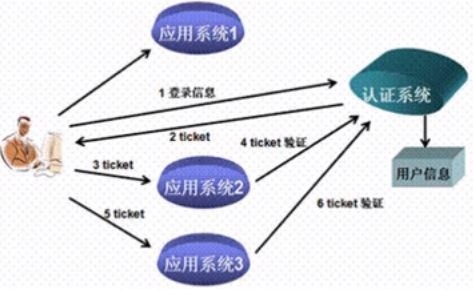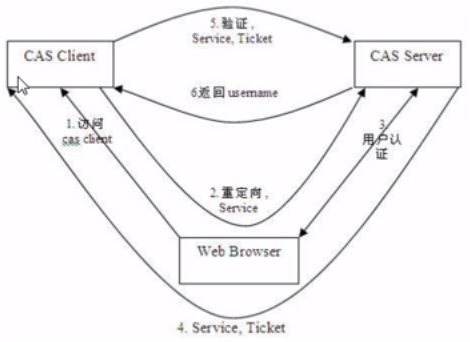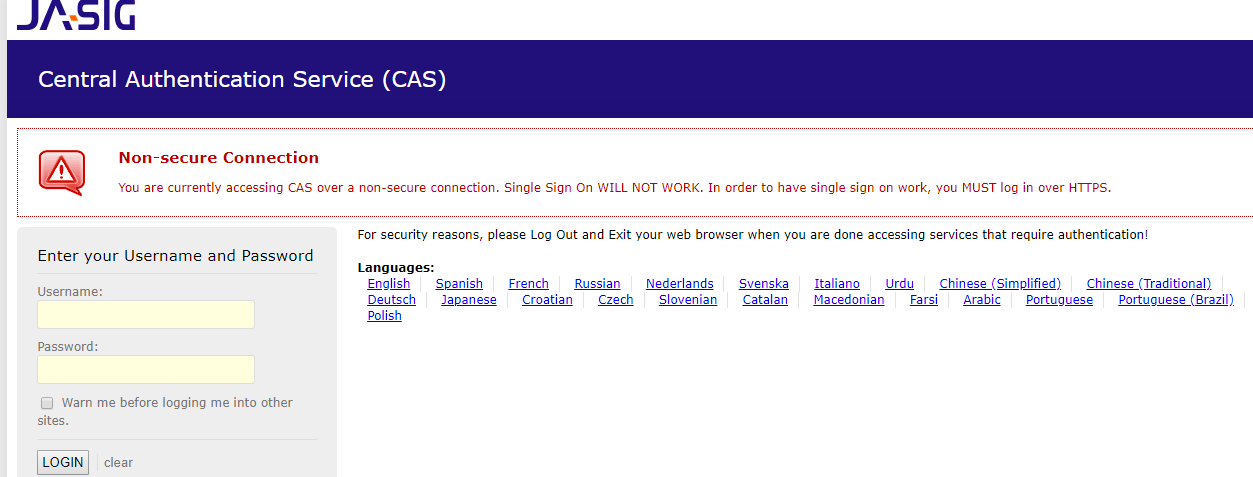1.什么是单点登录?
单点登录(signle sign on),简称SSO,是目前企业业务整合的解决方案之一。定义在多个应用系统中,只要进行一次登录就可以访问所有信任的应用系统。
2.单点登录的原理

当用户首次登录应用系统1时,会自动跳转到认证系统的登录页面进行登录,认证系统根据输入的信息与数据库对比,登录成功之后返回给用户一个票据;当用户再去访问应用系统2时就会携带票据给应用系统2,应用系统2拿着票据找认证系统进行验证,验证通过后就可以使用应用系统2,同时应用系统2已经有了用户的用户名等信息。
3.什么是cas?
cas是Yale大学开发的一个开源项目,为web应用系统提供一种可靠的单点登录方法。

4.部署cas服务端
解压一个tomcat,把cas.war放到webapp中,启动tomcat,在浏览器中输入localhost:8080/cas即可进入登录的页面。

这个页面是cas定义的,用户名是casuser,密码是Mellon。输入正确的用户名密码可以到登录成功的页面。
这个用户名和密码可以修改,打开webapps/cas/WEB-INF/deployerConfigContext.xml,找到
就可以在这里修改用户名和密码。
5.cas服务端配置
1)修改服务器的端口号
打开tomcat目录,在conf.server.xml中找到如下配置,将8080改为9100.

修改cas配置文件的端口。打开webapps/cas/WEB-INF/cas.properties,修改端口号:
server.name=http://localhost:9100
2)去除https认证
cas默认使用https协议,使用https协议需要ssl证书。为了方便测试,这里就去除https认证。
(1)修改cas/WEB-INF/deployerConfigContext.xml。
找到如下配置:
<bean id="proxyAuthenticationHandler" class="org.jasig.cas.authentication.handler.support.HttpBasedServiceCredentialsAuthenticationHandler"
p:httpClient-ref="httpClient" />
将其修改为
<bean id="proxyAuthenticationHandler" class="org.jasig.cas.authentication.handler.support.HttpBasedServiceCredentialsAuthenticationHandler"
p:httpClient-ref="httpClient"
p:requireSecure="false"/>
(2)修改cas\WEB-INF\spring-configuration\ticketGrantingTicketCookieGenerator.xml
<bean id="ticketGrantingTicketCookieGenerator" class="org.jasig.cas.web.support.CookieRetrievingCookieGenerator"
p:cookieSecure="true"
p:cookieMaxAge="-1"
p:cookieName="CASTGC"
p:cookiePath="/cas" />
把p:cookieSecure="true"的true改为false。p:cookieMaxAge="-1"的-1改为3600。
(3)修改cas\WEB-INF\spring-configuration\warnCookieGenerator.xml,修改如下:
<bean id="warnCookieGenerator" class="org.jasig.cas.web.support.CookieRetrievingCookieGenerator" p:cookieSecure="false" p:cookieMaxAge="3600" p:cookieName="CASPRIVACY" p:cookiePath="/cas" />
重启服务器,测试配置是否正常。
6.cas客户端入门小demo
1)新建一个maven的web工程,名为cas-demo1,添加依赖:
<dependencies>
<!-- cas -->
<dependency>
<groupId>org.jasig.cas.client</groupId>
<artifactId>cas-client-core</artifactId>
<version>3.3.3</version>
</dependency>
<dependency>
<groupId>javax.servlet</groupId>
<artifactId>servlet-api</artifactId>
<version>2.5</version>
<scope>provided</scope>
</dependency>
</dependencies>
<build>
<plugins>
<plugin>
<groupId>org.apache.maven.plugins</groupId>
<artifactId>maven-compiler-plugin</artifactId>
<version>2.3.2</version>
<configuration>
<source>1.8</source>
<target>1.8</target>
</configuration>
</plugin>
<plugin>
<groupId>org.apache.tomcat.maven</groupId>
<artifactId>tomcat7-maven-plugin</artifactId>
<configuration>
<!-- 指定端口 -->
<port>9001</port>
<!-- 请求路径 -->
<path>/</path>
</configuration>
</plugin>
</plugins>
</build>
2)配置web.xml,黄色背景的地方可根据实际情况修改:
<?xml version="1.0" encoding="UTF-8"?> <web-app xmlns="http://xmlns.jcp.org/xml/ns/javaee" xmlns:xsi="http://www.w3.org/2001/XMLSchema-instance" xsi:schemaLocation="http://xmlns.jcp.org/xml/ns/javaee http://xmlns.jcp.org/xml/ns/javaee/web-app_4_0.xsd" version="4.0"> <!-- 用于单点退出,该过滤器用于实现单点登出功能,可选配置 --> <listener> <listener-class>org.jasig.cas.client.session.SingleSignOutHttpSessionListener</listener-class> </listener> <!-- 该过滤器用于实现单点登出功能,可选配置。 --> <filter> <filter-name>CAS Single Sign Out Filter</filter-name> <filter-class>org.jasig.cas.client.session.SingleSignOutFilter</filter-class> </filter> <filter-mapping> <filter-name>CAS Single Sign Out Filter</filter-name> <url-pattern>/*</url-pattern> </filter-mapping> <!-- 该过滤器负责用户的认证工作,必须启用它 --> <filter> <filter-name>CASFilter</filter-name> <filter-class>org.jasig.cas.client.authentication.AuthenticationFilter</filter-class> <init-param> <param-name>casServerLoginUrl</param-name> <param-value>http://localhost:9100/cas/login</param-value> <!--这里的server是服务端的IP --> </init-param> <init-param> <param-name>serverName</param-name> <param-value>http://localhost:9001</param-value> </init-param> </filter> <filter-mapping> <filter-name>CASFilter</filter-name> <url-pattern>/*</url-pattern> </filter-mapping> <!-- 该过滤器负责对Ticket的校验工作,必须启用它 --> <filter> <filter-name>CAS Validation Filter</filter-name> <filter-class>org.jasig.cas.client.validation.Cas20ProxyReceivingTicketValidationFilter</filter-class> <init-param> <param-name>casServerUrlPrefix</param-name> <param-value>http://localhost:9100/cas</param-value> </init-param> <init-param> <param-name>serverName</param-name> <param-value>http://localhost:9001</param-value> </init-param> </filter> <filter-mapping> <filter-name>CAS Validation Filter</filter-name> <url-pattern>/*</url-pattern> </filter-mapping> <!-- 该过滤器负责实现HttpServletRequest请求的包裹, 比如允许开发者通过HttpServletRequest的getRemoteUser()方法获得SSO登录用户的登录名,可选配置。 --> <filter> <filter-name>CAS HttpServletRequest Wrapper Filter</filter-name> <filter-class>org.jasig.cas.client.util.HttpServletRequestWrapperFilter</filter-class> </filter> <filter-mapping> <filter-name>CAS HttpServletRequest Wrapper Filter</filter-name> <url-pattern>/*</url-pattern> </filter-mapping> <!-- 该过滤器使得开发者可以通过org.jasig.cas.client.util.AssertionHolder来获取用户的登录名。 比如AssertionHolder.getAssertion().getPrincipal().getName()。 --> <filter> <filter-name>CAS Assertion Thread Local Filter</filter-name> <filter-class>org.jasig.cas.client.util.AssertionThreadLocalFilter</filter-class> </filter> <filter-mapping> <filter-name>CAS Assertion Thread Local Filter</filter-name> <url-pattern>/*</url-pattern> </filter-mapping> </web-app>
3)新建一个index.jsp页面:
<%@ page contentType="text/html;charset=UTF-8" language="java" %> <html> <head> <title>Title</title> </head> <body> 欢迎来到cas测试demo1------登录名:<%=request.getRemoteUser()%> </body> </html>
4)再同上创建一个maven的web工程,名字为cas-demo2,端口号使用9002。
5)先启动cas服务器,然后分别启动cas-demo1和cas-demo2。
6)在浏览器输入localhost:9001回车,由于没有登录,所以会跳转到cas的登录页面,登录之后会显示首页信息,包括登录名。

7)然后直接访问localhost:9002,会直接显示这个项目的首页,原因是已经登录过了,就实现了一次登录,随处可用的效果。
7.退出登录
1)设置退出按钮。在index.jsp添加:
<a href="http://localhost:9100/cas/logout?service=http://www.baidu.com">退出登录</a>
2)设置允许重定向,添加退出后跳转的页面。打开cas\WEB-INF\cas-servlet.xml,修改配置:
<bean id="logoutAction" class="org.jasig.cas.web.flow.LogoutAction" p:servicesManager-ref="servicesManager" p:followServiceRedirects="${cas.logout.followServiceRedirects:true}"/>
重启服务器后进行退出登录测试,点击退出时会退出到百度的页面。
8.配置数据源
登录使用的用户名和密码一般是从数据库取的,所以要更改数据源。
打开cas\WEB-INF\deployerConfigContext.xml,在后面添加:
<bean id="dataSource" class="com.mchange.v2.c3p0.ComboPooledDataSource" p:driverClass="com.mysql.jdbc.Driver" p:jdbcUrl="jdbc:mysql://127.0.0.1:3306/ssm?characterEncoding=utf8" p:user="root" p:password="123456" /> <bean id="passwordEncoder" class="org.jasig.cas.authentication.handler.DefaultPasswordEncoder" c:encodingAlgorithm="MD5" p:characterEncoding="UTF-8" /> <bean id="dbAuthHandler" class="org.jasig.cas.adaptors.jdbc.QueryDatabaseAuthenticationHandler" p:dataSource-ref="dataSource" p:sql="select password from user where username = ?" p:passwordEncoder-ref="passwordEncoder"/>
找到下面的配置,
<bean id="authenticationManager" class="org.jasig.cas.authentication.PolicyBasedAuthenticationManager"> <constructor-arg> <map> <entry key-ref="proxyAuthenticationHandler" value-ref="proxyPrincipalResolver" /> <entry key-ref="primaryAuthenticationHandler" value-ref="primaryPrincipalResolver" /> </map> </constructor-arg>
将上面红色的部分改为:
<entry key-ref="dbAuthHandler" value-ref="primaryPrincipalResolver" />
在cas的lib加入三个jar包
c3p0-0.9.1.2.jar、 cas-server-support-jdbc-4.0.0.jar 、mysql-connector-java-5.1.32.jar
重启服务器,进行登录的测试。
9.修改登录页面
1)打开cas\WEB-INF\view\jsp\default\ui目录,删除文件casLoginView.jsp,然后新建文件casLoginView.jsp,内容如下:
<!DOCTYPE html> <%@ page pageEncoding="UTF-8" %> <%@ page contentType="text/html; charset=UTF-8" %> <%@ taglib prefix="c" uri="http://java.sun.com/jsp/jstl/core" %> <%@ taglib prefix="spring" uri="http://www.springframework.org/tags" %> <%@ taglib prefix="form" uri="http://www.springframework.org/tags/form" %> <%@ taglib prefix="fn" uri="http://java.sun.com/jsp/jstl/functions" %> <html lang="en"> <head> <meta charset="UTF-8" /> <title>cas登录</title> </head> <body> <p>用户登录</p> <form:form method="post" id="fm1" commandName="${commandName}" htmlEscape="true"> <p> <form:input id="username" size="25" tabindex="1" accesskey="${userNameAccessKey}" path="username" autocomplete="off" htmlEscape="true" /> </p> <p> <form:password id="password" size="25" tabindex="2" path="password" accesskey="${passwordAccessKey}" htmlEscape="true" autocomplete="off" /> </p> <p> <input type="hidden" name="lt" value="${loginTicket}" /> <input type="hidden" name="execution" value="${flowExecutionKey}" /> <input type="hidden" name="_eventId" value="submit" /> <input class="btn-submit" name="submit" accesskey="l" value="登录" tabindex="4" type="submit" /> </p> </form:form> </body>
重启服务器,进行登录测试,这时会发现登录界面已经换成了自己编写的登录页面,输入正确的用户名和密码可用跳转到上面的首页。
2)设置错误提示
打开cas\WEB-INF\classes\messages_zh_CN.properties,在后面添加错误显示的中文编码,下面表示的是用户名或密码错误的转义:
authenticationFailure.AccountNotFoundException=\u7528\u6237\u540d\u6216\u5bc6\u7801\u9519\u8bef
authenticationFailure.FailedLoginException=\u7528\u6237\u540d\u6216\u5bc6\u7801\u9519\u8bef
打开cas\WEB-INF\cas-servlet.xml文件,修改配置文件:
<bean id="localeResolver" class="org.springframework.web.servlet.i18n.CookieLocaleResolver" p:defaultLocale="zh_CN" />
打开cas\WEB-INF\view\jsp\default\ui\casLoginView.jsp文件,在密码文本框后添加一行代码,用来显示错误信息。这行代码也可用放在其他位置,但是必须是form表单里面。
<form:errors path="*" id="msg" cssClass="errors" element="div" htmlEscape="false" />
10.cas集成springsecurity
1)新建一个maven的web工程,名字为cas-springsecurity-demo,引入依赖和部分配置:
<properties>
<spring.version>4.2.4.RELEASE</spring.version>
</properties>
<dependencies>
<dependency>
<groupId>org.springframework</groupId>
<artifactId>spring-core</artifactId>
<version>${spring.version}</version>
</dependency>
<dependency>
<groupId>org.springframework</groupId>
<artifactId>spring-web</artifactId>
<version>${spring.version}</version>
</dependency>
<dependency>
<groupId>org.springframework</groupId>
<artifactId>spring-webmvc</artifactId>
<version>${spring.version}</version>
</dependency>
<dependency>
<groupId>org.springframework</groupId>
<artifactId>spring-context-support</artifactId>
<version>${spring.version}</version>
</dependency>
<dependency>
<groupId>org.springframework</groupId>
<artifactId>spring-test</artifactId>
<version>${spring.version}</version>
</dependency>
<dependency>
<groupId>org.springframework</groupId>
<artifactId>spring-jdbc</artifactId>
<version>${spring.version}</version>
</dependency>
<dependency>
<groupId>org.springframework.security</groupId>
<artifactId>spring-security-web</artifactId>
<version>4.1.0.RELEASE</version>
</dependency>
<dependency>
<groupId>org.springframework.security</groupId>
<artifactId>spring-security-config</artifactId>
<version>4.1.0.RELEASE</version>
</dependency>
<dependency>
<groupId>javax.servlet</groupId>
<artifactId>servlet-api</artifactId>
<version>2.5</version>
<scope>provided</scope>
</dependency>
<dependency>
<groupId>org.springframework.security</groupId>
<artifactId>spring-security-cas</artifactId>
<version>4.1.0.RELEASE</version>
</dependency>
<dependency>
<groupId>org.jasig.cas.client</groupId>
<artifactId>cas-client-core</artifactId>
<version>3.3.3</version>
<!--排除依赖其他包-->
<exclusions>
<exclusion>
<groupId>org.slf4j</groupId>
<artifactId>log4j-over-slf4j</artifactId>
</exclusion>
</exclusions>
</dependency>
</dependencies>
<build>
<plugins>
<!-- java编译插件 -->
<plugin>
<groupId>org.apache.maven.plugins</groupId>
<artifactId>maven-compiler-plugin</artifactId>
<version>3.2</version>
<configuration>
<source>1.8</source>
<target>1.8</target>
<encoding>UTF-8</encoding>
</configuration>
</plugin>
<plugin>
<groupId>org.apache.tomcat.maven</groupId>
<artifactId>tomcat7-maven-plugin</artifactId>
<configuration>
<!-- 指定端口 -->
<port>9003</port>
<!-- 请求路径 -->
<path>/</path>
</configuration>
</plugin>
</plugins>
</build>
2)配置web.xml:
<?xml version="1.0" encoding="UTF-8"?> <web-app xmlns="http://xmlns.jcp.org/xml/ns/javaee" xmlns:xsi="http://www.w3.org/2001/XMLSchema-instance" xsi:schemaLocation="http://xmlns.jcp.org/xml/ns/javaee http://xmlns.jcp.org/xml/ns/javaee/web-app_4_0.xsd" version="4.0"> <context-param> <param-name>contextConfigLocation</param-name> <param-value>classpath:spring-security.xml</param-value> </context-param> <listener> <listener-class> org.springframework.web.context.ContextLoaderListener </listener-class> </listener> <filter> <filter-name>springSecurityFilterChain</filter-name> <filter-class>org.springframework.web.filter.DelegatingFilterProxy</filter-class> </filter> <filter-mapping> <filter-name>springSecurityFilterChain</filter-name> <url-pattern>/*</url-pattern> </filter-mapping> <servlet> <servlet-name>springmvc</servlet-name> <servlet-class>org.springframework.web.servlet.DispatcherServlet</servlet-class> <!-- 指定加载的配置文件 ,通过参数contextConfigLocation加载--> <init-param> <param-name>contextConfigLocation</param-name> <param-value>classpath:springmvc.xml</param-value> </init-param> </servlet> <servlet-mapping> <servlet-name>springmvc</servlet-name> <url-pattern>*.do</url-pattern> </servlet-mapping> </web-app>
3)编写页面index.html,用于登录成功时显示的页面:
<!DOCTYPE html> <html lang="en"> <head> <meta charset="UTF-8"> <title>首页</title> </head> <body> 欢迎来到spring security<a href="logout/cas">退出登录</a> </body> </html>
4)编写配置文件spring-security.xml
<?xml version="1.0" encoding="UTF-8"?> <beans:beans xmlns="http://www.springframework.org/schema/security" xmlns:beans="http://www.springframework.org/schema/beans" xmlns:xsi="http://www.w3.org/2001/XMLSchema-instance" xsi:schemaLocation="http://www.springframework.org/schema/beans http://www.springframework.org/schema/beans/spring-beans.xsd http://www.springframework.org/schema/security http://www.springframework.org/schema/security/spring-security.xsd"> <!-- entry-point-ref 入口点引用 --> <http use-expressions="false" entry-point-ref="casProcessingFilterEntryPoint"> <intercept-url pattern="/**" access="ROLE_USER"/> <csrf disabled="true"/> <!-- custom-filter为过滤器, position 表示将过滤器放在指定的位置上,before表示放在指定位置之前 ,after表示放在指定的位置之后 --> <custom-filter ref="casAuthenticationFilter" position="CAS_FILTER" /> <custom-filter ref="requestSingleLogoutFilter" before="LOGOUT_FILTER"/> <custom-filter ref="singleLogoutFilter" before="CAS_FILTER"/> </http> <!-- CAS入口点 开始 --> <beans:bean id="casProcessingFilterEntryPoint" class="org.springframework.security.cas.web.CasAuthenticationEntryPoint"> <!-- 单点登录服务器登录URL --> <beans:property name="loginUrl" value="http://localhost:9100/cas/login"/> <beans:property name="serviceProperties" ref="serviceProperties"/> </beans:bean> <beans:bean id="serviceProperties" class="org.springframework.security.cas.ServiceProperties"> <!--service 配置自身工程的根地址+/login/cas --> <beans:property name="service" value="http://localhost:9003/login/cas"/> </beans:bean> <!-- CAS入口点 结束 --> <!-- 认证过滤器 开始 --> <beans:bean id="casAuthenticationFilter" class="org.springframework.security.cas.web.CasAuthenticationFilter"> <beans:property name="authenticationManager" ref="authenticationManager"/> </beans:bean> <!-- 认证管理器 --> <authentication-manager alias="authenticationManager"> <authentication-provider ref="casAuthenticationProvider"> </authentication-provider> </authentication-manager> <!-- 认证提供者 --> <beans:bean id="casAuthenticationProvider" class="org.springframework.security.cas.authentication.CasAuthenticationProvider"> <beans:property name="authenticationUserDetailsService"> <beans:bean class="org.springframework.security.core.userdetails.UserDetailsByNameServiceWrapper"> <beans:constructor-arg ref="userDetailsService" /> </beans:bean> </beans:property> <beans:property name="serviceProperties" ref="serviceProperties"/> <!-- ticketValidator 为票据验证器 --> <beans:property name="ticketValidator"> <beans:bean class="org.jasig.cas.client.validation.Cas20ServiceTicketValidator"> <beans:constructor-arg index="0" value="http://localhost:9100/cas"/> </beans:bean> </beans:property> <beans:property name="key" value="an_id_for_this_auth_provider_only"/> </beans:bean> <!-- 认证类 --> <beans:bean id="userDetailsService" class="com.service.UserDetailsServiceImpl"/> <!-- 认证过滤器 结束 --> <!-- 单点登出 开始 --> <beans:bean id="singleLogoutFilter" class="org.jasig.cas.client.session.SingleSignOutFilter"/> <beans:bean id="requestSingleLogoutFilter" class="org.springframework.security.web.authentication.logout.LogoutFilter"> <beans:constructor-arg value="http://localhost:9100/cas/logout?service=http://www.baidu.com"/> <beans:constructor-arg> <beans:bean class="org.springframework.security.web.authentication.logout.SecurityContextLogoutHandler"/> </beans:constructor-arg> <beans:property name="filterProcessesUrl" value="/logout/cas"/> </beans:bean> <!-- 单点登出 结束 --> </beans:beans>
后期需要改变地址,只需要将橙色背景的地方改成应的地址即可。
5)编写配置文件springmvc.xml
<?xml version="1.0" encoding="UTF-8"?> <beans xmlns="http://www.springframework.org/schema/beans" xmlns:xsi="http://www.w3.org/2001/XMLSchema-instance" xmlns:mvc="http://www.springframework.org/schema/mvc" xmlns:context="http://www.springframework.org/schema/context" xsi:schemaLocation="http://www.springframework.org/schema/beans http://www.springframework.org/schema/beans/spring-beans-3.2.xsd http://www.springframework.org/schema/mvc http://www.springframework.org/schema/mvc/spring-mvc-3.2.xsd http://www.springframework.org/schema/context http://www.springframework.org/schema/context/spring-context-3.2.xsd"> <context:component-scan base-package="com" /> <mvc:annotation-driven /> </beans>
6)新建一个包com.service,创建类UserDetailsServiceImpl
package com.service; import org.springframework.security.core.GrantedAuthority; import org.springframework.security.core.authority.SimpleGrantedAuthority; import org.springframework.security.core.userdetails.User; import org.springframework.security.core.userdetails.UserDetails; import org.springframework.security.core.userdetails.UserDetailsService; import org.springframework.security.core.userdetails.UsernameNotFoundException; import java.util.ArrayList; import java.util.List; public class UserDetailsServiceImpl implements UserDetailsService { //在这里不需要验证,由cas验证。这个类被调用时cas已经进行了验证 @Override public UserDetails loadUserByUsername(String username) throws UsernameNotFoundException { List<GrantedAuthority> grantedAuthorities = new ArrayList<>(); grantedAuthorities.add(new SimpleGrantedAuthority("ROLE_USER")); return new User(username,"",grantedAuthorities); } }
7)新建一个包com.controller,创建类UserController,这个类是用来获取登录名的:
package com.service.controller; import org.springframework.security.core.context.SecurityContextHolder; import org.springframework.web.bind.annotation.RequestMapping; import org.springframework.web.bind.annotation.RestController; @RestController public class UserController { @RequestMapping("getUserName") public String getUserName(){ String name = SecurityContextHolder.getContext().getAuthentication().getName(); return name; } }
8)测试。
启动cas服务器和端口是9003的tomcat,在浏览器输入localhost:9003,就会跳转到登录页面,登录成功后会跳转到index.html。
在浏览器输入localhost:9003/getUserName.do,即可获取登录的用户名。在index.html中点击退出登录可用跳转到百度。